|
As
the British Government were unable to supply the aircraft needed and
requested by New Zealand in 1942, negotiations between the United States
and New Zealand Governments took place, and a Mutual Aid Agreement (Lease/Lend)
was signed. Thirteen fighter squadrons (numbers 14 - 26 equipped with P-40ís then F4Uís), Six bomber squadrons (numbers 1- 5 and 9 equipped with Hudsonís then PV-1 Venturas), Two flying boat squadrons (numbers 5 and 6 with PBY-5 Catalinas), One dive bomber squadron (number 25 with SBD-5 Dauntlessís) and Two torpedo bomber squadrons (numbers 30 and 31 with TBF-1c Avengers) served tours of duty in the operational area from late 1942. These units were supported by 40 and 41 (Transport) Squadrons flying C-47's and Lockheed C-61 Loadstars The
first fighter squadron to go into action was 15 Squadron who became
operational on Guadalcanal in April 1943 during the heavy fighting during
this period. The self-contained squadron was equipped with P-40Kís and
Mís. A continual shuttle then followed with the squadrons serving a tour (usually 6 weeks) in the frontal area, then leaving their aircraft to be flown by the relieving squadron, and being transported back to the rear area for rest and further training before returning for a further tour. By
the time the P-40ís were phased out and replaced by the F4U-1A and -1D
Corsairs, most of the Japanese air strength had been decimated, and
the Corsairs never scored any confirmed kills.
It was soon realised by the RNZAF Command in New Zealand that they wouldnít have the manpower to support each operational squadron as a self contained unit, so a system of Servicing Units (S.U.) was put into place. All aircraft were ĎOwnedí and serviced by these units, and issued to the squadrons as necessary. It was therefore rare for any one pilot to have an individual aircraft exclusively, so nose art was very rare on later RNZAF fighter aircraft. The S.U.s added any individual markings required for tactical purposes. This system was continued until the end of 1945. On
the 23rd of March 1944, the SBDís of 25 (Dive-Bomber) Squadron,
and the TBF-1cís of 30 (Torpedo Bomber) Squadron arrived at Piva airstrip
on Bougainville during the massive Japanese counter attack on the perimeter
which had started on the 8th of March.
Throughout
this period, 6 then 5 (Flying Boat) Squadrons with their PBY-5 and PB2B-1
Catalinaís had been flying anti-submarine and air sea rescue patrols
around the Southwest Pacific and several hair raising rescues were carried
out in bad weather. By
the cessation of hostilities on 15th August, 1945, the RNZAF
squadrons were fully committed in the Northern Solomons area, and were
at this time under full RNZAF control as the main front had shifted
to Borneo and the Phillipines areas.
|


